Father William Norvel, SSJ, superior general of the Josephites, a Pascagoula native and former pastor in Natchez, will celebrate the 50th anniversary of his ordination to the priesthood on March 27 with a Mass and celebration in Moss Point.
He is the first African-American to be elected Superior General of the Josephites, who were founded to serve the African-American community in its 143-year history and he is the only African American to head a community of Catholic priests in the United States.
Father Norvel is the oldest child and only son of the late William and Velma (Wilson) Norvel. He attended St. Peter Elementary School and Our Mother of Sorrows High School in Biloxi. After being told in the early 1950s by the archdiocese that there was “no place in the church” for him, young William Norvel was invited by his pastor, Father Edward Lawlor, to join the Josephites. Supported by family, friends and his pastor, he left Pascagoula by train following his junior year in high school to enter the seminary in Newburg, NY.
He was ordained on March 27, 1965, at the Cathedral-Basilica of St. Louis in New Orleans and offered his first Mass at St. Peter the next day. Friends, family and parishioners who traveled from Pascagoula by bus to the ordination were briefly detained by police who mistook them for “freedom riders.” They were released only when Father Lawlor spotted the bus and stopped to verify their identity and destination.
Father Norvel’s first assignment was at Holy Family Parish in Natchez, Miss. There, he had a brief run-in with the Ku Klux Klan when “city officials” objected to a dance that was being held for teenagers.
Father Norvel stood up to them affirming the right of the church to have safe and wholesome activities for youth. Father has since served as pastor at St. Benedict the Moor in Washington, D.C., St. Brigid in Los Angeles, Calif., Most Pure Heart of Mary in Mobile, Ala., St. Francis Xavier in Baton Rouge, La., St. Francis Xavier in Baltimore, Md., (the Mother parish of African-American Catholics), St. Peter the Apostle Church in Pascagoula, Miss., and Our Lady of Perpetual Help in Washington, D.C.
He has also taught at St. Augustine High School in New Orleans, the Josephite flagship school, and was briefly on the faculty of Notre Dame University and the Institute for Pastoral Ministry in the Black Community at Loyola Marymount University.
Father Norvel has bachelor and master’s degrees in education and philosophy from St. Joseph Seminary in Washington, D.C. He is a member of the Knights of St. Peter Claver, the Knights of Columbus and the National Association of Superiors General.
Category Archives: U.S. News
Franciscan leader in Black Catholic ministry named auxiliary bishop
WASHINGTON (CNS) – Pope Francis has named Franciscan Father Fernand “Ferd” Cheri III, a New Orleans native who currently is director of campus ministry at Quincy University in Illinois, as an auxiliary bishop of the Archdiocese of New Orleans. Father Cheri has visited the Diocese of Jackson on many occasions, leading and attending workshops here.
The appointment was announced Jan. 12 in Washington by Archbishop Carlo Maria Vigano, apostolic nuncio to the United States.
Bishop-designate Cheri, 63, has a background that includes extensive roles in black Catholic liturgy, music and spirituality, in addition to having served on the Franciscans’ provincial council and as their director of friar life.
He also is a board member of the National Black Catholic Congress and has been involved in activities including the NBCC gatherings, the U.S. bishops’ subcommittee on Black Catholic worship and the National Joint Conference of Black Religious Planning Committee.
He originally was ordained as a priest for the Archdiocese of New Orleans May 20, 1978. He studied at Notre Dame University and at the Institute for Black Catholic Studies at Xavier University, both in New Orleans.
During a news conference in New Orleans after his appointment was announced, Bishop-designate Cheri said he never truly left his hometown and was surprised but thrilled that Pope Francis had appointed him as auxiliary bishop in the city where most of his family still lives. He said he is pleased that he will be working alongside Archbishop Gregory V. Aymond.
“I’d like to say first of all thank you to Pope Francis for appointing me to this position,” he said.
“It was a total surprise, but it was a wonderful moment to just be told that I was appointed auxiliary bishop,” added Bishop-designate Cheri. “I also want to thank Greg for accepting me in this position as well. I look forward to just working with the people of New Orleans again. I never left New Orleans. It’s always a part of me. Wherever I go, I bring New Orleans. It’s going to be great to be back in the city.”
Bishop-designate Cheri will be ordained bishop at a Mass March 23 at 2 p.m. at St. Louis Cathedral.
“He is very gifted in music and preaching and liturgy,” Archbishop Aymond said. “This is also a very significant moment, I think, for us as New Orleans (Catholics) – another hometown boy joining us again. But also a great gift from the African-American community to the church and to the archdiocese.”
As a diocesan priest for four years at four parishes in New Orleans and Marrero, La., Bishop-designate Cheri was involved in ministry in the black Catholic community. It was at that time that he began discernment in becoming a Franciscan.
He entered the novitiate for the Order of Friars Minor, in the Sacred Heart Province, based in St. Louis, in 1992 and made his solemn profession as a Franciscan two years later. Since then he has served as a chaplain at Hales Franciscan High School in Chicago and as pastor of St. Vincent de Paul Church in Nashville, Tenn.
He also served as a choir director and guidance counselor at Althoff Catholic High in Belleville, Ill., while part of a contingent that launched St. Benedict the Black Friary in East St. Louis, an outreach to the poor, African-American community.
Prior to beginning his position at Quincy University in 2011, he was director of campus ministry at Xavier University in New Orleans. In addition to his post at Quincy, he is vicar of Holy Cross Friary, located on the campus.
Bishop-designate Cheri said he organized teams of students from Quincy University to provide annual cleanup and repairs in New Orleans. Last year, 50 students made the mission trip.
The New Orleans Archdiocese has had no auxiliary bishops since Bishop Shelton J. Fabre was named in 2013 to become bishop of Houma-Thibodaux. Auxiliary Bishop Dominic Carmon retired in 2006.
(Contributing to this story was Peter Finney Jr. in New Orleans.)
Supreme Court to take on marriage cases
WASHINGTON (CNS) – The Supreme Court Jan. 16 agreed to hear four cases over the constitutionality of same-sex marriage, tackling the questions of whether the 14th Amendment requires states to allow such marriages and whether it requires them to recognize same-sex marriages licensed in other states.
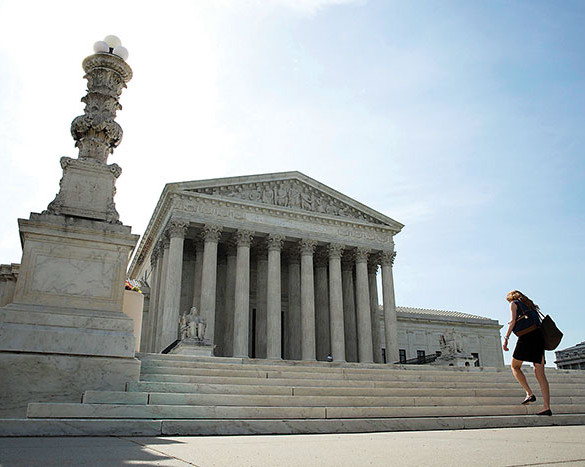
A woman walks to the U.S. Supreme Court in Washington late last year. On Oct. 6, 2014 the court declined to hear appeals on rulings striking down same-sex marriage bans. This cleared the path for same-sex marriages to be legally recognized in more states, but also caused some confusion and disappointment for those on both sides of the issue. (CNS phopto/Joshua Roberts, Reuters)
In brief orders, the court accepted petitions from Tennessee, Michigan, Kentucky and Ohio, consolidating them into one hearing that will be held probably in late April, meaning a decision would likely come before the end of the term in late June. The court allotted an unusually lengthy period of time for oral arguments, two and a half hours, compared to a typical 60-minute period.
As of Jan. 16, 36 states and the District of Columbia allow same-sex marriages, either under court rulings or state laws. In the other 14 states, they are prohibited, but those bans are all under legal challenge.
The Catholic Church upholds marriage as a union between one man and one woman and teaches that any sexual activity outside of marriage is sinful. The church also teaches that homosexual attraction itself is not sinful and that homosexual people “must be accepted with respect, compassion and sensitivity.”
The chairman of the U.S. bishops’ Subcommittee for the Promotion and Defense of Marriage said that a decision by the Supreme Court on whether a state may define marriage as the union of one man and one woman “may be the most significant court decision since the court’s tragic 1973 Roe v. Wade decision making abortion a constitutional right.”
“It’s hard to imagine how the essential meaning of marriage as between the two sexes, understood in our nation for over 200 years, and consistent with every society throughout all of human history, could be declared illegal,” Archbishop Salvatore J. Cordileone of San Francisco said in a Jan. 16 statement.
Upholding traditional marriage “is not a judgment on anyone,” he said. “It is a matter of justice and truth. The central issue at stake is: what is marriage? The answer is: a bond which unites a man and a woman to each other and to any children who come from their union.”
After the court announced it would take the marriage cases, U.S. Attorney General Eric Holder said the Obama administration would file an amicus, or friend of the court, brief calling for a decision by the justices that would “make marriage equality a reality for all Americans.”
James Esseks, director of the Lesbian Gay Bisexual Transgender & HIV Project of the American Civil Liberties Union, said in a statement the ACLU was “thrilled the court will finally decide this issue. … The country is ready for a national solution that treats lesbian and gay couples fairly.” The ACLU is a co-counsel in the Kentucky case.
In 2013 the Supreme Court — in separate 5-4 rulings — struck down parts of the federal Defense of Marriage Act, or DOMA, defining marriage as between one man and one woman, and also refused to rule on the merits of a challenge to California’s Proposition 8, the voter-approved initiative barring same-sex marriage.
In the June 26 ruling on DOMA, the court said the federal government could not deny benefits to same-sex couples that were legally married in states that allow such unions based on the Equal Protection Clause. The justices the same day sent back to lower courts a challenge to Prop 8, saying the individuals who defended the law in court lacked the legal standing to do so. On June 28, 2013, a stay on allowing same-sex marriage in California was lifted and such marriages were able to resume.
During his trip to the Philippines, Pope Francis made one of his strongest calls as pope against movements to recognize same-sex unions as marriage.
“The family is also threatened by growing efforts on the part of some to redefine the very institution of marriage,” the pope said Jan. 16, hours after warning that Philippine society was “tempted by confusing presentations of sexuality, marriage and the family.”
Mother Delille effort in hands of Vatican investigators
The Sisters of the Holy Family in New Orleans await authentication of a miracle of the Venerable Henriette Delille, their founder, as her cause for sainthood moves through the final steps. Sister Delille was the first native-born African American to have her cause for canonization officially opened by the church. In 2010 Pope Benedict XVI declared her venerable. The authentication of one more miracle would result in beatification.
In September of this year the congregation 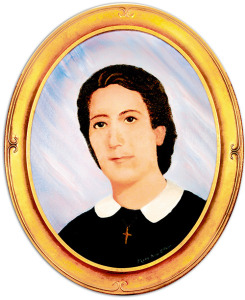 unveiled a portrait of their founder. The nine-by-four-foot painting by artist Ulrick Jean-Pierre was commissioned by late congregational leader, Sister Eva Regina Martin, SHF, and hangs in the motherhouse. It shows Sister Delille surrounded by the poor she served for her whole life with St. Augustine church in the background.
unveiled a portrait of their founder. The nine-by-four-foot painting by artist Ulrick Jean-Pierre was commissioned by late congregational leader, Sister Eva Regina Martin, SHF, and hangs in the motherhouse. It shows Sister Delille surrounded by the poor she served for her whole life with St. Augustine church in the background.
Delille was born a free woman of color in New Orleans in 1812. She was born into a family of concubines and may have even borne two sons who died as toddlers, but she had a conversion at the age of 24. At that time African-American women were not allowed in any religious order. Undaunted, Sister Delille studied with white nuns to learn about religious life. She and two friends formed a society, professed their own vows and started serving the poor and elderly of color in their community.
The group was recognized years later as the Sisters of the Holy Family. Last year two members of the congregation came to the Diocese of Jackson to encourage devotion to their founder in hopes of advancing her cause.
Sisters Doris Goudeaux and Laura Mercier, both SHF, said during their 2013 presentation that the Sisters of the Holy Family begged for support from the very start of their order. “No matter how they were treated, they depended on the Divine Providence of God,” said Sister Goudeaux. “They knew no matter what they suffered they would be rewarded. They knew they were doing what Jesus wanted them to do.” They picked up poor elderly and children off the streets and found a way to care for them. The Sisters are credited with opening the first nursing home in the United States, a ministry they are still running in New Orleans.
They educated slaves and made sure they were baptized as well as caring for those affected by yellow fever. In many cases, they had to teach their students in secret with little or no reliable support. “They begged in the street daily and some days they went to bed having only had sugar water,” said Sister Goudeaux.
Sister Delille died at the age of 50. Only one example of her writing exists, a simple but profound prayer she penned in the flyleaf of a book on the Eucharist right after her conversion. The congregation still uses the prayer today, encouraging others to say it. “I believe in God. I hope in God. I love. I want to live and die for God.”
USCCB leader: walk with families, help them grow closer to mercy of Jesus
By Patricia Zapor
BALTIMORE (CNS) – Acknowledging that families come with complications, the president of the U.S. Conference of Catholic Bishops reminded his fellow bishops Nov. 10 that their role is to accompany their family of the church through their fears and concerns.
“Evangelizing means witnessing to our hope in Jesus,” said Archbishop Joseph E. Kurtz of Louisville, Kentucky, in opening the USCCB’s annual fall general assembly in Baltimore. It was his first address as conference president.
“As pastors, we accompany so many families who face their own fears and concerns and who yearn to experience the love of Jesus in and through his loving family – the church,” he said. “Together, brothers, we seek to walk with these families and to build their confidence in faith.”
Archbishop Kurtz framed his remarks around a conversation he had recently with Italian journalist Paolo Rodari, who has a brother with Down syndrome. Archbishop Kurtz for many years was responsible for the care of his late brother, who also had Down syndrome.
The two discussed how they learned to communicate with their brothers through the things that were important to their siblings – film and books – and that they otherwise could be difficult to understand.
“Paolo has learned to understand Giovanni, because they’re family,” Archbishop Kurtz said, continuing the metaphor as an example of what the bishops are called to do – “walk with our brothers and sisters, helping them grow closer to Jesus through his mercy.”
He noted that Pope Francis has said the church is “a place of mercy freely given, where everyone can feel welcomed, loved, forgiven and encouraged to live the good life of the Gospel.”
The archbishop commented about some of his experiences over the last year as USCCB president – such as visiting the Philippines with Catholic Relief Services to see the relief work after Typhoon Haiyan, and the conference’s work on issues such as religious freedom and respect for life.
“We all strive to be faithful pastors, so we know what this looks like,” he said. “Think of the home visits we’ve all done in parishes. When I’d come to someone’s home, I wouldn’t start by telling them how I’d rearrange their furniture. In the same way, I wouldn’t begin by giving them a list of rules to follow.
“Instead, I’d first spend time with them, trying to appreciate the good that I saw in their hearts. I’d acknowledge that, like them, I was in the process of conversion toward greater holiness,” the archbishop said.
“I would then invite them to follow Christ and I’d offer to accompany them as we, together, follow the Gospel invitation to turn from sin and journey along the way. Such an approach isn’t in opposition to church teachings; it’s an affirmation of them.”
(Copyright © 2014 Catholic News Service/United States Conference of Catholic Bishops. The CNS news services may not be published, broadcast, rewritten or otherwise distributed, including but not limited to, such means as framing or any other digital copying or distribution method in whole or in part, without prior written authority of Catholic News Service.)
Media created ‘tale of two synods’ say bishops
By Mark Pattison
BALTIMORE (CNS) – October’s extraordinary Synod of Bishops on the family was just one event, but “a tale of two synods” emerged from it, according to the president of the U.S. Conference of Catholic Bishops (USCCB).
Speaking to reporters Nov. 10 after the morning session of the USCCB’s annual fall general assembly in Baltimore, Archbishop Joseph E. Kurtz of Louisville, Kentucky, acknowledged the differences in the synod experienced by the bishops participating in it and news accounts disseminated outside the synod.
Those differences were highlighted by Cardinal Timothy M. Dolan of New York in remarks delivered during the assembly’s morning session.
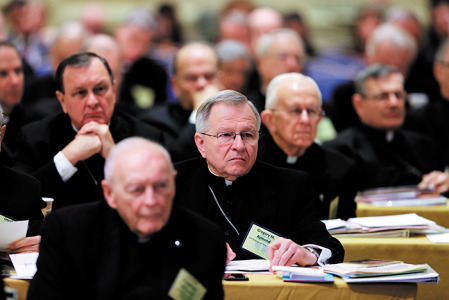
Archbishop Gregory M. Aymond of New Orleans, center, listens to a speaker Nov. 10 during the annual fall general assembly of the U.S. Conference of Catholic Bishops in Baltimore. Behind him on the left is Archbishop Thomas Rodi of Mobile, Metropolitan Archbishop for the Diocese of Jackson. (CNS photo/Bob Roller
“There must have been two synods,” he said, and the participating U.S. bishops “happened to be at the wrong one.”
From what he said he had heard and read about the synod, one synod was “confrontational and divisive,” “hijacked by left-wing dissenters intent on eluding doctrine,” with proceedings “smothered by new Ottavianis, dug in to resist the fresh breeze” of change, Cardinal Dolan said, referring to Italian Cardinal Alfredo Ottaviani known for his opposition to the changes being brought about in the church during the Second Vatican Council.
“Too bad we missed that one,” Cardinal Dolan added. “The one we were at was hardly as spicy (and) juicy.”
The synod Cardinal Dolan said he attended “was a synod of consensus. This synod was led by a pope with a radical charism for attentive listening,” he said of Pope Francis, adding the only time the pope spoke was in “reciting the Angelus – twice.”
At this synod, “we listened to married couples who found God’s love in one another and their kids,” Cardinal Dolan said. “At this synod, we listened to bishops form Africa who said the (church’s) teaching on marriage, so widely dismissed in the First World, was enhancing their culture. … We saw brother bishops asking how we can expedite and simplify marriage (annulment) cases.”
It was at this synod, Cardinal Dolan said, that “life-giving marriage” was the focus of “meeting the most urgent vocation crisis of the times.”
Archbishop Kurtz, in addressing his fellow bishops, noted that each one of the 62 paragraphs that constituted the final “relatio,” or report, of the synod met with majority approval — and all but three of the paragraphs with approval by at least two-thirds of those voting.
Cardinal Donald W. Wuerl of Washington, at a news conference following the morning session, said Pope Francis had asked that the “votation” be published along with the text to indicate the degree of accord shared at the synod.
Archbishop Kurtz said there were 12 documents in all to be considered at the synod before the final “relatio” was discussed: the first two “relatios” – one offered at the synod’s beginning and a second draft issued mid-synod – plus separate documents produced by each of 10 small working groups.
“The work of the second ‘relatio’ was the work of the small groups,” Archbishop Kurtz told reporters.
Cardinal Wuerl added that press covering the synod and those bishops participating in it “have different perspectives.”
“So many people tend to reflect now in terms of sound bites,” he said. “In the church, we’re learning to speak a little more crisply, but our teaching is not reducible to sound bites.”
He noted it took some time for the final “relatio” to be translated into English from the official Italian. But he urged the bishops to wait for the translation, noting that the final “relatio” serves as the “lineamenta,” or outline, for next year’s world Synod of Bishops.
Archbishop Kurtz said the Vatican was holding a meeting later in November to construct a system of reflection for bishops’ conferences to use in seeking input from dioceses to be used in preparation for next year’s synod.
(Editor’s note: Bishop Joseph Kopacz attended the USCCB meeting.)
(Copyright © 2014 Catholic News Service/United States Conference of Catholic Bishops. The CNS news services may not be published, broadcast, rewritten or otherwise distributed, including but not limited to, such means as framing or any other digital copying or distribution method in whole or in part, without prior written authority of Catholic News Service.)
Pope Francis’ closing speech: let Holy Spirit guide us
(These are excerpts from a provisional translation of Pope Francis’ speech from Vatican Radio at the closing of the Synod. The full text is available online at https://en.radiovaticana.va/news/2014/10/18/pope_francis_speech_at_the_conclusion_of_the_synod/1108944.)
I can happily say that – with a spirit of collegiality and of synodality – we have truly lived the experience of “Synod,” a path of solidarity, a “journey together.”
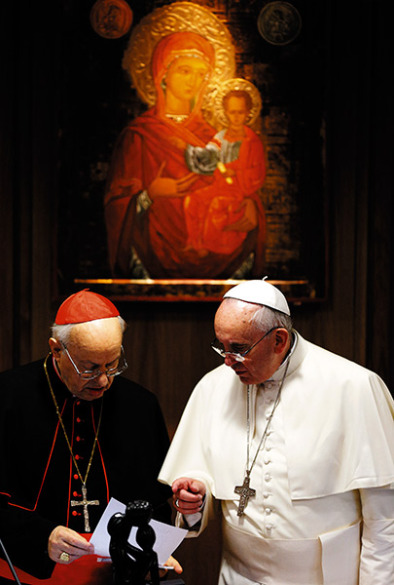
Pope Francis talks with Italian Cardinal Lorenzo Baldisseri, general secretary of the Synod of Bishops, during the morning session on the final day of the extraordinary Synod of Bishops on the family at the Vatican Oct. 18. (CNS photo/Paul Haring)
And it has been “a journey” – and like every journey there were moments of running fast, as if wanting to conquer time and reach the goal as soon as possible; other moments of fatigue, as if wanting to say “enough”; other moments of enthusiasm and ardour. There were moments of profound consolation listening to the testimony of true pastors, who wisely carry in their hearts the joys and the tears of their faithful people. Moments of consolation and grace and comfort hearing the testimonies of the families who have participated in the Synod and have shared with us the beauty and the joy of their married life. A journey where the stronger feel compelled to help the less strong, where the more experienced are led to serve others, even through confrontations. And since it is a journey of human beings, with the consolations there were also moments of desolation, of tensions and temptations, of which a few possibilities could be mentioned:
— One, a temptation to hostile inflexibility, that is, wanting to close oneself within the written word, (the letter) and not allowing oneself to be surprised by God, by the God of surprises, (the spirit); within the law, within the certitude of what we know and not of what we still need to learn and to achieve. From the time of Christ, it is the temptation of the zealous, of the scrupulous, of the solicitous and of the so-called – today – “traditionalists” and also of the intellectuals.
— The temptation to a destructive tendency to goodness [it. buonismo], that in the name of a deceptive mercy binds the wounds without first curing them and treating them; that treats the symptoms and not the causes and the roots. It is the temptation of the “do-gooders,” of the fearful, and also of the so-called “progressives and liberals.”
— The temptation to transform stones into bread to break the long, heavy, and painful fast (cf. Lk 4:1-4); and also to transform the bread into a stone and cast it against the sinners, the weak, and the sick (cf Jn 8:7), that is, to transform it into unbearable burdens (Lk 11:46).
— The temptation to come down off the Cross, to please the people, and not stay there, in order to fulfil the will of the Father; to bow down to a worldly spirit instead of purifying it and bending it to the Spirit of God.
— The temptation to neglect the “depositum fidei” [the deposit of faith], not thinking of themselves as guardians but as owners or masters [of it]; or, on the other hand, the temptation to neglect reality, making use of meticulous language and a language of smoothing to say so many things and to say nothing! They call them “byzantinisms,” I think, these things…
Personally I would be very worried and saddened if it were not for these temptations and these animated discussions; this movement of the spirits, as St Ignatius called it (Spiritual Exercises, 6), if all were in a state of agreement, or silent in a false and quietist peace. Instead, I have seen and I have heard – with joy and appreciation – speeches and interventions full of faith, of pastoral and doctrinal zeal, of wisdom, of frankness and of courage: and of parresia. And I have felt that what was set before our eyes was the good of the Church, of families, and the “supreme law,” the “good of souls” (cf. Can. 1752). And this always – we have said it here, in the Hall – without ever putting into question the fundamental truths of the Sacrament of marriage: the indissolubility, the unity, the faithfulness, the fruitfulness, that openness to life (cf. Cann. 1055, 1056; and Gaudium et spes, 48).
And this is the Church, the vineyard of the Lord, the fertile Mother and the caring Teacher, who is not afraid to roll up her sleeves to pour oil and wine on people’s wound; who doesn’t see humanity as a house of glass to judge or categorize people. This is the Church, One, Holy, Catholic, Apostolic and composed of sinners, needful of God’s mercy. This is the Church, the true bride of Christ, who seeks to be faithful to her spouse and to her doctrine. It is the Church that is not afraid to eat and drink with prostitutes and publicans. The Church that has the doors wide open to receive the needy, the penitent, and not only the just or those who believe they are perfect! …
This is the Church, our Mother! And when the Church, in the variety of her charisms, expresses herself in communion, she cannot err: it is the beauty and the strength of the sensus fidei, of that supernatural sense of the faith which is bestowed by the Holy Spirit so that, together, we can all enter into the heart of the Gospel and learn to follow Jesus in our life. And this should never be seen as a source of confusion and discord …
We will speak a little bit about the Pope, now, in relation to the Bishops [laughing]. So, the duty of the Pope is that of guaranteeing the unity of the Church; it is that of reminding the faithful of their duty to faithfully follow the Gospel of Christ; it is that of reminding the pastors that their first duty is to nourish the flock – to nourish the flock – that the Lord has entrusted to them, and to seek to welcome – with fatherly care and mercy, and without false fears – the lost sheep. I made a mistake here. I said welcome: [rather] to go out and find them.
His duty is to remind everyone that authority in the Church is a service, as Pope Benedict XVI clearly explained, with words I cite verbatim: “The Church is called and commits herself to exercise this kind of authority which is service and exercises it not in her own name, but in the name of Jesus Christ…”
So, the Church is Christ’s – she is His bride – and all the bishops, in communion with the Successor of Peter, have the task and the duty of guarding her and serving her, not as masters but as servants. The Pope, in this context, is not the supreme lord but rather the supreme servant – the “servant of the servants of God”; the guarantor of the obedience and the conformity of the Church to the will of God, to the Gospel of Christ, and to the Tradition of the Church, putting aside every personal whim, despite being – by the will of Christ Himself – the “supreme Pastor and Teacher of all the faithful” (Can. 749) and despite enjoying “supreme, full, immediate, and universal ordinary power in the Church” (cf. Cann. 331-334).
Dear brothers and sisters, now we still have one year to mature, with true spiritual discernment, the proposed ideas and to find concrete solutions to so many difficulties and innumerable challenges that families must confront; to give answers to the many discouragements that surround and suffocate families. …
May the Lord accompany us, and guide us in this journey for the glory of His Name, with the intercession of the Blessed Virgin Mary and of Saint Joseph. And please, do not forget to pray for me! Thank you!
[The hymn Te Deum was sung, and Benediction given.]
Thank you, and rest well, eh?
(Reprinted with permission from Vatican Radio)
(Copyright © 2014 Catholic News Service/United States Conference of Catholic Bishops. The CNS news services may not be published, broadcast, rewritten or otherwise distributed, including but not limited to, such means as framing or any other digital copying or distribution method in whole or in part, without prior written authority of Catholic News Service.)
Synod dynamics recalled Second Vatican Council
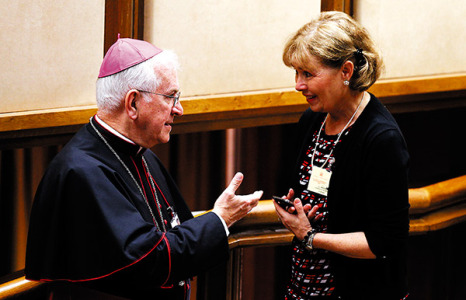
Archbishop Joseph E. Kurtz of Louisville, Ky., president of the U.S. Conference of Catholic Bishops, speaks with Alice Heinzen before the morning session of the extraordinary Synod of Bishops on the family at the Vatican Oct. 18. Heinzen and her husband Jeff, from Menomonie, Wis., are auditors at the synod. (CNS photo/Paul Haring)
By Francis X. Rocca
VATICAN CITY (CNS) – Even before the start of the Oct. 5-19 Synod of Bishops on the family, observers were likening it to the Second Vatican Council of 1962-65.
In both cases, an innovative and charismatic pope called an assembly in the first months of his pontificate, seeking to preach the Gospel in terms of contemporary culture and apply Catholic teaching with what St. John XXIII called the “medicine of mercy.”
As it turned out, history also repeated itself in the institutional dynamics of this year’s event, as bishops from around the world asserted their collective authority, leading the assembly’s organizers in Rome to revise some of their best-laid plans.
A classic history, “The Rhine Flows into the Tiber,” recounts the first tumultuous week of Vatican II, when bishops rejected the Vatican’s handpicked candidates for the commissions that would write the council documents.
“It was not a revolutionary act, but an act of conscience, an act of responsibility on the part of the council fathers,” recalled Pope Benedict XVI in 2013. Then-Father Joseph Ratzinger attended Vatican II as a theological adviser to Cardinal Josef Frings of Cologne, Germany, one of the leaders of the bishops’ resistance.
More than 50 years later, bishops at the synod on the family reacted strongly after the Oct. 13 presentation of an official midterm report by Hungarian Cardinal Peter Erdo of Esztergom-Budapest.
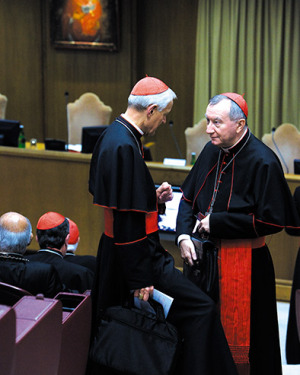
Cardinal Pietro Parolin, the Vatican’s secretary of state, right, talks with Cardinal Donald Wuerl of Washington prior to the start of a consistory for the canonizations of Giuseppe Vaz and Maria Cristina dell’Immacolata Concezione in the Synod Hall a t the Vatican Oct. 20. (CNS photo/Maria Grazia Picciarella, pool)
Cardinal Erdo’s report, which was supposed to summarize the assembly’s first week of discussions, made headlines with its strikingly conciliatory language toward people with ways of life contrary to Catholic teaching, including divorced and remarried Catholics, cohabitating couples and people in same-sex unions.
Immediately after the cardinal spoke, 41 of the 184 synod fathers present took the floor to comment. A number objected that the text lacked certain necessary references to Catholic moral teaching, particularly regarding homosexuality and cohabitation. Bishops also remarked on the midterm report’s scarce references to the concept of sin.
“Three-quarters of those who spoke had some problems with the document,” Cardinal George Pell, prefect of the Secretariat for the Economy, told Catholic News Service. He called the report tendentious, skewed and without sufficient grounding in Scripture and traditional doctrine.
At a news conference Monday, Oct. 13, Cardinal Erdo distanced himself from the midterm report, identifying Italian Archbishop Bruno Forte of Chieti-Vasto, the synod’s special secretary, as responsible for a particularly controversial passage on same-sex unions.
Later that afternoon, the synod fathers divided into 10 working groups to discuss the midterm report and suggest amendments for the synod’s final document.
The midterm report was “seen by many as not being as balanced as it should have been,” Cardinal Donald W. Wuerl of Washington told CNS.
Cardinal Wuerl, one of 11 members of a team that drafted the synod’s final report, said one common objection was to the theological concept of “graduality,” which the midterm report used, among other ways, to suggest the positive value of “irregular” relationships such as cohabitation.
“You don’t see that in the final document because the small language groups said, ‘Yes, it was said, but it didn’t garner support,” the cardinal said.
The synod’s leadership, under Cardinal Lorenzo Baldisseri, who served as general secretary, planned not to publish the working groups’ individual reports but provide them only to the drafters of the final report, along with their approximately 450 suggested amendments.
But on Oct. 16, the bishops insisted that the working-groups’ reports be made public.
“We wanted the Catholic people around the world to know actually what was going on in talking about marriage and the family,” Cardinal Pell said.
On the same day, the drafting committee was expanded to increase its geographic diversity, with the addition of Cardinal Wilfrid F. Napier of Durban, South Africa, and Archbishop Denis Hart of Melbourne, Australia. Just as bishops from a cluster of northern European countries had been leaders of change at Vatican II, some of the more outspoken synod fathers this year were from the English-speaking countries and Africa.
The synod’s final report, which the pope ordered published almost immediately after the assembly finished its work Oct. 18, featured many more citations of Scripture, as well as new references to the Catechism of the Catholic Church and the teachings of Blessed Paul VI, St. John Paul II and Pope Benedict XVI.
Synod fathers voted on each of the document’s 62 paragraphs. All received a simple majority, but three – on especially controversial questions of homosexuality and Communion for the divorced and civilly remarried – failed to gain the two-thirds supermajority ordinarily required for approval of synodal documents.
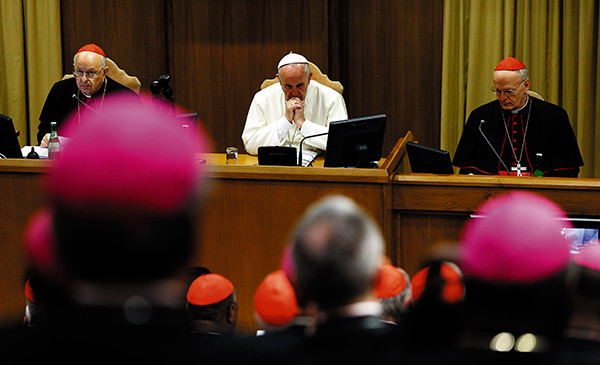
Pope Francis attends the morning session on the final day of the extraordinary Synod of Bishops on the family at the Vatican Oct. 18. At left is Cardinal Lorenzo Baldisseri, general secretary of the Synod of Bishops, and at right Cardinal Peter Erdo of Esztergom-Budapest, Hungary, relator for the synod. (CNS photo/Paul Haring)
“What I think Pope Francis succeeded in doing was letting the synod fathers, letting the synod participants, actually come to a real consensus, even though it’s a weak consensus in some areas,” Cardinal Wuerl said. “The process worked, even though there were bumps along the way.”
(Copyright © 2014 Catholic News Service/United States Conference of Catholic Bishops. The CNS news services may not be published, broadcast, rewritten or otherwise distributed, including but not limited to, such means as framing or any other digital copying or distribution method in whole or in part, without prior written authority of Catholic News Service.)
Liturgical items top USCCB meeting agenda
By Mark Pattison
WASHINGTON (CNS) — Liturgical matters will take center stage on the agenda of action items at the fall general meeting of the U.S. Conference of Catholic Bishops, (USCCB) to be held Nov. 10-13 in Baltimore. Bishop Joseph Kopacz will attend the meeting.
There will be five liturgical items up for consideration. All are subject to amendments from bishops. All but one require approval of two-thirds of the bishops, followed by final approval from the Vatican.
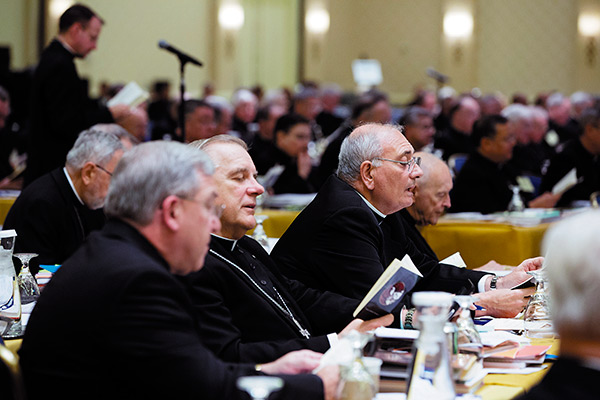
In this 2013 file photo, members of the U.S. Conference of Catholic Bishops pray before an afternoon session during the bishops’ annual fall meeting in Baltimore. Liturgical matters will take center stage during this year’s meeting, to be held Nov. 10-13 in Baltimore. (CNS photo/Nancy Phelan Wiechec)
Archbishop Joseph E. Kurtz of Louisville, Kentucky, who is president of the USCCB, will deliver his first presidential address. He was elected to a three-year term last November. As is customary, Archbishop Carlo Maria Vigano, apostolic nuncio to the United States, also will address the assembly.
During the meeting, the bishops will choose a new secretary-elect for the USCCB, and vote for the chairmen-elect of five committees. A number of presentations will be made, including one on underserved communities and Catholic schools, and another on a recent pilgrimage of prayer for peace in the Holy Land.
The bishops also will conduct the canonical consultation on the sainthood cause of Father Paul Wattson. Father Wattson was an Episcopal priest who co-founded the Society of the Atonement, also known as the Franciscan Friars and Sisters of the Atonement, to further Christian unity. He was received into the Catholic Church as were all men and women in the society at the time, and devised the Week of Prayer for Christian Unity, still observed each January.
On the first day of the meeting, the bishops will concelebrate Mass at the Basilica of the Assumption of the Blessed Virgin Mary in Baltimore in honor of the 225th anniversary of the establishment of the Archdiocese of Baltimore. Baltimore was the first diocese founded in the United States. The bishops had similarly marked the bicentennial of the U.S. hierarchy in 1989 with a Mass at the basilica.
The liturgical items up for consideration:
— A revised translation of the ritual book “Dedication of a Church and Altar,” used whenever a new church is built or when a new altar is made. The revised English translation incorporates the modifications from the Code of Canon Law as well as bringing the translation into conformity with the Roman Missal, Third Edition.
— A first-ever official English translation of the ritual book “Exorcisms and Related Supplications,” revised after the Second Vatican Council, and promulgated in Latin in 1999 with an amended version in 2004. The main part of this book is the rite of major exorcism and includes an introduction outlining criteria for its use, which is always the decision of the bishop alone. While this text affirms the reality of evil in the world, it even more so affirms the sovereignty of Jesus to overcome any and all evil.
— A supplement to the Liturgy of the Hours of an English translation of the prayers used for the feast days of saints who have been added to the general calendar since 1984.
— Modifications to the Revised Grail Psalms, originally approved in 2010 by the Vatican. The USCCB Committee on Divine Worship recommended improving the translation and its “sprung rhythm” to make proclamation and singing easier.
The fifth liturgy-related item would authorize rewriting for later approval guidelines from its 1995 document “Guidelines for the Celebration of the Sacraments with Persons with Disabilities” in light of medical developments and increased awareness of challenges faced by Catholics today, such as gluten intolerance, also known as celiac disease.
Other action items to be addressed by the bishops include the 2015 USCCB budget, the 2016 diocesan assessment, and a proposal to proceed on a revision to the “Ethical and Religious Directives for Catholic Health Care Services.”
In USCCB elections, Archbishops Gregory M. Aymond of New Orleans and Timothy P. Broglio of the Archdiocese for the Military Services have been nominated as secretary-elect. The five committees seeking chairmen-elect, and their bishop-nominees, are:
— Committee on Communications: Bishop William F. Murphy of Rockville Centre, New York, and Archbishop Joseph F. Naumann of Kansas City, Kansas.
— Committee on Cultural Diversity in the Church: Archbishop Gustavo Garcia-Siller of San Antonio, and Bishop Joseph J. Tyson of Yakima, Washington.
— Committee on Doctrine: Bishop Robert J. McManus of Worcester, Massachusetts, and Archbishop Allen H. Vigneron of Detroit.
— Committee on National Collections: Archbishop Thomas J. Rodi of Mobile, Alabama, and Bishop Jaime Soto of Sacramento, California.
— Committee on Pro-Life Activities: Cardinal Timothy M. Dolan of New York and Archbishop Jose H. Gomez of Los Angeles.
The secretary-elect and the chairmen-elect will serve one year in that capacity and then begin a three-year term.
The bishops also will vote on members for the board of the Catholic Legal Immigration Network and Catholic Relief Services, the USCCB’s international aid and development agency, as well as hear a presentation by Archbishop Paul S. Coakley of Oklahoma City, chairman of the CRS board, and CRS president Carolyn Woo on CRS’ work on capacity building.
Other presentations scheduled for the USCCB meeting:
— Underserved communities and Catholic schools, presented by Archbishop George J. Lucas of Omaha, Nebraska, chairman of the Committee on Catholic Education, and Bishop Daniel E. Flores of Brownsville, Texas, chairman of the Committee on Cultural Diversity in the Church.
— The pilgrimage of prayer for peace in the Holy Land, presented by Bishop Richard E. Pates of Des Moines, Iowa, chairman of the Committee on International Justice and Peace.
— USCCB engagement with the church in Africa, presented by Cardinal Theodore E. McCarrick, retired archbishop of Washington.
— The observance of the Year of Consecrated Life and the “Guidelines for the Reception of Ministers in the United States, Third Edition” and plans for their implementation, presented by Bishop Michael F. Burbidge of Raleigh, North Carolina, chairman of the Committee on Clergy, Consecrated Life and Vocations.
— A status report on the 2013-16 USCCB strategic plan, “The New Evangelization: Faith, Worship, Witness,” presented by Archbishop J. Peter Sartain of Seattle, USCCB secretary,
— Separate reports by Archbishop Salvatore J. Cordileone of San Francisco, chairman of the Subcommittee for the Promotion and Defense of Marriage; Archbishop William E. Lori of Baltimore, chairman of the Ad Hoc Committee for Religious Liberty; and the USCCB working group on the life and dignity of the human person.
(Copyright © 2014 Catholic News Service/United States Conference of Catholic Bishops. The CNS news services may not be published, broadcast, rewritten or otherwise distributed, including but not limited to, such means as framing or any other digital copying or distribution method in whole or in part, without prior written authority of Catholic News Service.)
Vocations awareness week invites prayer, discussion
By Norma Montenegro Flynn, USCCB
WASHINGTON — The Catholic Church in the United States will celebrate National Vocation Awareness Week, November 2-8. This observance, sponsored by the U.S. bishops’ Committee on Clergy, Consecrated Life and Vocations, is a special time for parishes in the U.S. to foster a culture of vocations for the priesthood, diaconate and consecrated life.
Pope Francis, in his November 2013 apostolic exhortation, Evangelii G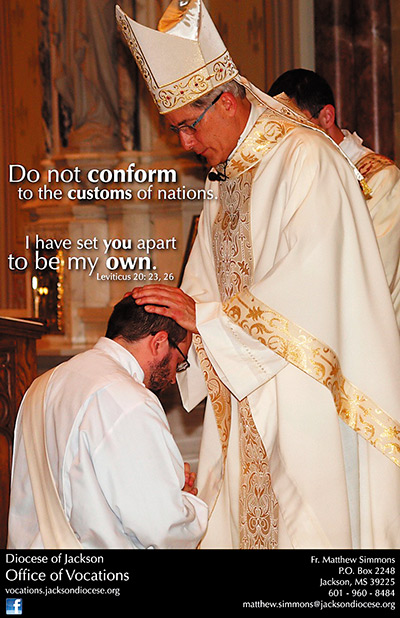 audium, underlined the continued need to build a culture of vocations. “The fraternal life and fervor of the community can awaken in the young a desire to consecrate themselves completely to God and to preaching of the Gospel. This is particularly true if such a living community prays insistently for vocations and courageously proposes to its young people the path of special consecration,” Pope Francis wrote.
audium, underlined the continued need to build a culture of vocations. “The fraternal life and fervor of the community can awaken in the young a desire to consecrate themselves completely to God and to preaching of the Gospel. This is particularly true if such a living community prays insistently for vocations and courageously proposes to its young people the path of special consecration,” Pope Francis wrote.
“A culture of vocations is one that provides the necessary support for others to hear and respond to God’s call in their lives,” said Bishop Michael F. Burbidge of Raleigh, North Carolina, chairman of the U.S. bishops’ Committee on Clergy, Consecrated Life and Vocations. “With God’s grace, we help build that culture through fervent prayer, the witness of our lives and the encouragement we extend to those discerning a vocation to priesthood or consecrated life.”
A 2012 study, “Consideration of Priesthood and Religious Life Among Never-Married U.S. Catholics,” conducted by the Georgetown University-based Center for Applied Research in the Apostolate (CARA), highlighted the role community encouragement plays in the discernment process. (Full study: www.usccb.org/beliefs-and-teachings/vocations/survey-of-youth-and-young-adults-on-vocations.cfm)
“The number three seems to be critical in making a difference in the life of someone contemplating a vocation,” said Father Shawn McKnight, USCCB’s executive director of Clergy, Consecrated Life and Vocations. “When three or more people encourage someone to consider a religious vocation, he or she is far more likely to take serious steps toward answering that call.”
Father John Guthrie, associate director of Clergy, Consecrated Life and Vocations, adds that National Vocation Awareness Week should also focus on communities that are underrepresented among religious vocations today, especially Hispanics.
“While numbers of U.S. Hispanics pursuing religious vocations are picking up, they still lag behind the overall demographic trends,” said Father Guthrie. “Fifty-four percent of U.S. Catholics under the age of 25 are Hispanic, yet only 15 percent of students in major seminaries are Hispanic, and many of these were born in other countries. To reach this untapped potential, the Church must do far more to engage and support young people in these communities.”
Observance of Vocation Awareness Week began in 1976 when the U.S. bishops designated the 28th Sunday of the year for the celebration. It was later moved to Feast of the Baptism of the Lord in January. Last year, after extensive consultation, the Committee on Clergy, Consecrated Life and Vocations moved the observance of National Vocation Awareness Week to November to engage Catholic schools and colleges more effectively in this effort. This will be the first year it will be held in November.
More information and resources for National Vocations Awareness Week, including a prayer card, suggested prayers of the faithful and bulletin-ready quotes are available online at www.usccb.org/beliefs-and-teachings/vocations/national-vocation-awareness-week.cfm
(Copyright © 2014 Catholic News Service/United States Conference of Catholic Bishops. The CNS news services may not be published, broadcast, rewritten or otherwise distributed, including but not limited to, such means as framing or any other digital copying or distribution method in whole or in part, without prior written authority of Catholic News Service.)
